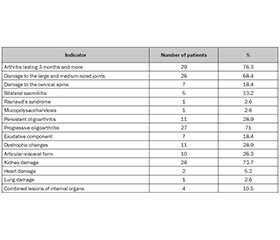Журнал «Здоровье ребенка» Том 19, №3, 2024
Вернуться к номеру
Роль інтерлейкіну-17 при ювенільному ідіопатичному артриті
Авторы: I.A. Karimdzhanov, M.Sh. Madaminova
Tashkent Medical Academy, Tashkent, Uzbekistan
Рубрики: Педиатрия/Неонатология
Разделы: Клинические исследования
Версия для печати
Захворювання суглобів є актуальною проблемою педіатрії. Ювенільний ідіопатичний артрит є поширеним хронічним системним запальним захворюванням суглобів у дітей; його етіологічні фактори залишаються невідомими. Захворювання може вражати дітей будь-якого віку і характеризується тривалим прогресуючим перебігом, що призводить до розвитку контрактур і функціональної недостатності, а згодом і до інвалідності. На думку авторів статті, рівень інтерлейкіну-17 у сироватці крові дітей із ювенільним ідіопатичним артритом залежить від тривалості захворювання, а також його тяжкості.
Joint diseases is a pressing problem of pediatrics. Juvenile idiopathic arthritis is a common chronic systemic inflammatory disease of the joints in children; its etiological factors remain completely unknown. The disease can affect children of any age and is characterized by a long progressive course, leading to the development of contractures and functional failure, and thereby disability. According to the authors of the article, the content of the interleukin-17 in the blood serum of children with juvenile idiopathic arthritis depends on the duration of the disease, as well as its severity.
діти; ювенільний ідіопатичний артрит; цитокіни
children; juvenile idiopathic arthritis; cytokines
Для ознакомления с полным содержанием статьи необходимо оформить подписку на журнал.
- Alekseeva EI, Litvitsky PF. Juvenile idiopathic arthritis: etiology, pathogenesis, clinical picture, diagnostic and treatment algorithms. Moscow: VEDI; 2017. 308 p.
- Voronina MS, Shilkina NP, Vinogradov AA. The role of laboratory research methods in the diagnosis and treatment of idiopathic arthritis. Therapist. 2019;1:34-38.
- Emelyanchik EYu, Salmina AB. Clinical dynamics of juvenile idio–pathic arthritis. Attending Physician. 2021;3:71-74.
- Ignatovich TV, Zafranskaya MM. The immunopathogenesis of fibrosis. Immunopathology, Allergology, Infectology. 2019;1:6-17.
- Karimdzhanov IF, Iskanova KH, Israilova NA, Dinmuhammadieva DR, Madadaminova MSh. Juvenile Idiopathic Arthritis: Etiopathogenesis, Therapy and Outcomes. Journal of Pharmaceutical Negative Results. 2022;13(8):498-506.
- Karimdzhanov IA, Dinmukhammadieva DR, Iskanova GH, Yusupova GA, Mallaev ShSh, Madaminova MSh. Juvenile idiopathic arthritis and osteochondrosis of the lumbosacral joint. Clinical case. Eurasian Bulletin of Pediatrics. 2022;3(14):26-30.
- Karstila K, Korpela M, Sihvonen S, Mustonen J. Prognosis of clinical renal disease and incidence of new renal findings in patients with rheumatoid arthritis: follow-up of a population-based study. Clin Rheumatol. 2019;26(12):2089-2095.
- Kuzmina NI, Shokh BP, Nikishina IP. Modern view of systemic glucocorticosteroid therapy for juvenile rheumatoid arthritis. Scientific and Practical Rheumatology. 2020;2:56-62.
- Makarova TP, et al. Kidney damage in juvenile rheumatoid arthritis. Pediatrician. 2016;7(2);206.
- Matvienko EV, et al. Clinical and immunological features of the course of juvenile idiopathic arthritis in children and adolescents. Bulletin of Volgograd State Medical University. 2018;1(65):118-121.
- Petty RE, Laxer RM, Wedderburn LR. Chapter 15. Juvenile Idio–pathic Arthritis. Textbook of Pediatric Rheumatology (Seventh Edition). WB Saunders; 2016. 188-204.e6. doi: 10.1016/B978-0-323-24145-8.00015-6.
- Krumrey-Langkammerer M, Häfner R. Evaluation of the ILAR criteria for juvenile idiopathic arthritis. J Rheumatol. 2001 Nov;28(11):2544-7.
- Hsu JJ, Lee TC, Sandborg CI. Chapter 107. Clinical Features and Treatment of Juvenile Idiopathic Arthritis. Kelley and Firestein’s Textbook of Rheumatology (Tenth Edition). Elsevier; 2017. 1826-1843.e6. doi: 10.1016/B978-0-323-31696-5.00107-8.
- Alekseeva EI. Juvenile idiopathic arthritis: clinical picture, diagnosis, treatment. Issues of Modern Pediatrics. 2015;14(1):78-94. doi: 10.15690/vsp.v14i1.1266.
- Zaripova LN, Midgley A, Christmas SE, Beresford MW, Baildam EM, Oldershaw RA. Juvenile idiopathic arthritis: from aetiopathogenesis to therapeutic approaches. Pediatr Rheumatol Online J. 2021 Aug 23;19(1):135. doi: 10.1186/s12969-021-00629-8.
- Wedderburn LR, Bending D, Nistala K. Chapter 106. Etiology and Pathogenesis of Juvenile Idiopathic Arthritis. Kelley and Firestein’s Textbook of Rheumatology (Tenth Edition). Elsevier; 2017. 1816-1825. doi: 10.1016/B978-0-323-31696-5.00106-6.
- Martini A, Ravelli A, Avcin T, Beresford MW, Burgos-Vargas R, et al.; Pediatric Rheumatology International Trials Organization (PRINTO). Toward New Classification Criteria for Juvenile Idiopathic Arthritis: First Steps, Pediatric Rheumatology International Trials Organization International Consensus. J Rheumatol. 2019 Feb;46(2):190-197. doi: 10.3899/jrheum.180168.
- De Benedetti F, Schneider R. Chapter 16. Systemic Juvenile Idio–pathic Arthritis. Textbook of Pediatric Rheumatology (Seventh Edition). WB Saunders; 2016. 205-216.e6. doi: 10.1016/B978-0-323-24145-8.00016-8.
- Rosenberg AM, Oen KG. Chapter 17. Polyarticular Juvenile Idio–pathic Arthritis. Textbook of Pediatric Rheumatology (Seventh Edition). WB Saunders; 2016. 217-228.e6. doi: 10.1016/B978-0-323-24145-8.00017-X.
- Nigrovic PA, Sundel RP. Chapter 20. Juvenile Psoriatic Arthritis. Textbook of Pediatric Rheumatology (Seventh Edition). WB Saunders; 2016. 256-267.e5. doi: 10.1016/B978-0-323-24145-8.00020-X.
- Tse SML, Petty RE. Chapter 19. Enthesitis Related Arthritis. Textbook of Pediatric Rheumatology (Seventh Edition). WB Saunders; 2016. 238-255.e6. doi: 10.1016/B978-0-323-24145-8.00019-3.

